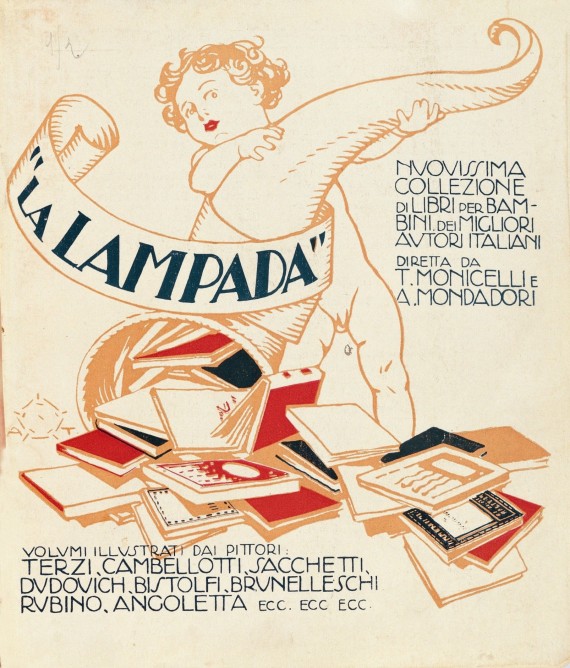1912
Arnoldo Mondadori publishes his first book.

The jump in quality: la Lampada
Still publishing advertisement posters and flyers, Arnoldo Mondadori dreams of becoming a publisher. He starts to realise the plan together with Tomaso Monicelli, his close friend and brother-in-law. They make the first attempt ever in Italy to produce a book series directed at a specific audience: school-age children. In 1912, they publish their first book Aia Madama, a collection of novels for children by Tomaso Monicelli. The next year with Il Piccolo Viandante (The Little Traveler), also by Monicelli, they inaugurate their first book series, Bibliotechina della Lampada (Little Library of the Lamp).
Their books are not simply “children’s books”, but rather a “series of books that are easy to read and can accompany textbooks”. With a slim and almost square format, these volumes had an illustrated cardboard cover, used high quality paper and made use of images to break up the text that was surrounded by a coloured border.
Among the best works in the first Lampada series, published between 1912 and 1914, there are La Signorina Zesi (Miss Zesi) by Antonio Beltramelli, La primavera di Giorgio (Giorgio’s Spring), sold to Mondadori by Luigi Capuana for 250 lire, and I tre talismani (The Three Talismans), a collection of six fairy tales by Guido Gozzano. In 1919, Mondadori published Fiabette Bislacche (Peculiar Fairy Tales) by Gian Bistolfi, dedicated to Arnoldo’s first-born Alberto.
In the meantime, the number of authors and illustrators was growing. Among the most famous ones there were Olga Visentini, who would subsequently direct Romanzo dei Ragazzi, , Térésah, Yambo (Enrico Novelli) Sto (Sergio Tofano). In addition to them, there were also other illustrators that would have a leading role in Italian illustration of the 20th Century. Notable examples include Enrico Mauro Pinochi, Filiberto Scarpelli, who drew the series logo, an oil lamp, and finally Ang, pseudonym of Bruno Angoletta, who was just beginning a long-lasting and fruitful collaboration with the publishing house.
The Lampada books, divided in series of six volumes each, were regularly published until 1927. Their success was so long-lasting that, between 1933 and 1946, Mondadori decided to publish a new series, partly made up by reissues. During the war, the collection of the famous volumes from Bibliotechina della Lampada represented the only publication by the editor.